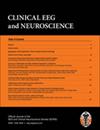与老年性听力损失有关的中枢听觉变化
IF 1.7
4区 医学
Q3 CLINICAL NEUROLOGY
引用次数: 0
摘要
研究目的本研究旨在探讨皮层听觉诱发电位(CAEPs)与年龄相关的变化,同时考虑三个关键因素:年龄、高频听力损失和 CAEPs 刺激的感觉水平。研究方法采用多元回归分析法对71名老年参与者的电生理和听力数据进行分析,研究CAEPs与年龄、高频听力损失和CAEP测试刺激感觉水平等因素的关系。结果发现衰老与 N1 和 P2 潜伏期的延长以及 P2 振幅的减小明显相关。与 CAEP 刺激感觉水平相关的阈值升高与 N1 和 P2 振幅增大和 N1 延迟减小明显相关。高频听阈与 P2 潜伏期缩短和 P2 振幅减小之间存在明显关系。结论本研究的结果凸显了衰老、高频听力损失和 CAEP 刺激的感觉水平对老年人 CAEP 成分的复杂相互作用。在今后使用 CAEPs 进行研究时,应考虑这些因素,以加深对老年人听觉处理过程的全面了解。本文章由计算机程序翻译,如有差异,请以英文原文为准。
Central Auditory Changes Associated with Age-related Hearing Loss
Objective. This study aimed to investigate age-related changes in cortical auditory evoked potentials (CAEPs) while considering three crucial factors: aging, high-frequency hearing loss and sensation level of the CAEP stimulus. Method. The electrophysiological and audiometric data of 71 elderly participants were analyzed using multiple regression analysis to investigate the association of CAEPs with the factors of aging, high-frequency hearing loss and sensation level of the CAEP test stimulus. Results. Aging was significantly associated with prolonged N1 and P2 latencies and reduced P2 amplitude. Elevated thresholds related to the sensation level of the CAEP stimulus were significantly associated with increased N1 and P2 amplitudes and decreased N1 latency. A significant relationship was detected between high-frequency hearing thresholds and the shortening of P2 latencies and the reduction of P2 amplitudes. Conclusion. The results of this study highlight the complex interplay of aging, high-frequency hearing loss and the sensation level of the CAEP stimulus on CAEP components in elderly people. These factors should be considered in future research using CAEPs to enhance overall understanding of auditory processing in the aging population.
求助全文
通过发布文献求助,成功后即可免费获取论文全文。
去求助
来源期刊

Clinical EEG and Neuroscience
医学-临床神经学
CiteScore
5.20
自引率
5.00%
发文量
66
审稿时长
>12 weeks
期刊介绍:
Clinical EEG and Neuroscience conveys clinically relevant research and development in electroencephalography and neuroscience. Original articles on any aspect of clinical neurophysiology or related work in allied fields are invited for publication.
 求助内容:
求助内容: 应助结果提醒方式:
应助结果提醒方式:


